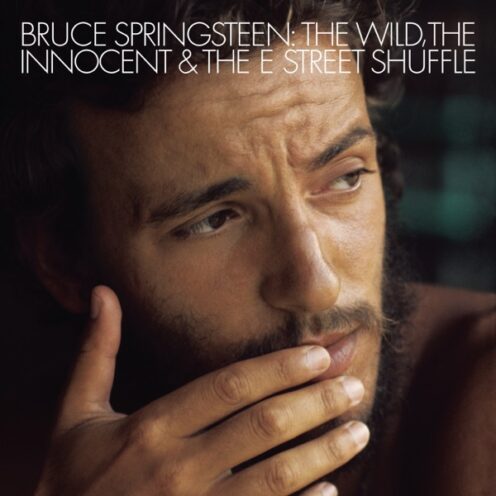
With Columbia Records disappointed at the result of Greetings From Asbury Park, N.J., there was only one thing for Bruce Springsteen to do – give it another chance. So what did he do? He wrote, recorded and released an entire record in less than a year. Even lessthan less than a year, if that makes sense. Greetings was released on Jan. 5, 1973. The Wild, The Innocent& The E Street Shuffle came out barely seven months later – on Sep. 11, 1973.
Perhaps more impressive than the short turnaround is the quantum leap between the two records. Shuffle is more rock’n’roll while at the same time being more funky, the lyricism is improved to an exponential power, and it is the recorded debut of Springsteen’s E Street Band. An interesting point is that when Springsteen started off, he signed a contract with Columbia Records for Bruce Springsteen – no E Street Band existed for quite a while. Even on Shuffle, only three members of the E Street Band would continue on to work with The Boss for his entire career.
The Wild, The Innocent & The E Street Shuffle bore what at the time was a nauseating amount of resemblances to Greetings. It was received even more warmly by critics than its predecessor, but it was equally as much of an atomic explosion on the Billboard charts. Only after Springsteen released Born To Run did choice cuts from this record end up seeing some love on FM radio. When you break down Shuffle, the first thing you notice is that it seems short – it only has seven songs. But holy macaroni, are they a solid group of songs. And if you were worried about the shortness of the record, worry no longer; those seven songs total to over 45 minutes of the sexiest rock music ever made.
This record was the spark for Springsteen’s rise to fame. Although he was only seven months older than he was when he released his first record, Springsteen grew up a lot in that time, and it is reflected by his lyricism. What listeners will encounter on this record is poetry – equal parts witty and clever as it is deep and complex. There are full-length stories in play here, which partially explains the lengthiness of each track. Opener “The E Street Shuffle” introduces listeners to a host of characters who supposedly live on E Street. We identify with future heroes and heroines and with the oppressive nature of the police, who, along with many characters on this record, return in glorious form (and in different names) on Born To Run. The depth of the characters and storylines is something that not many will be able to understand, and after countless listens to this record andBorn To Run, is not something I claim to have familiarized myself with completely. To describe Springsteen’s poetry on Shuffle is not something that can be done in a review, but might be better accomplished in a series of lengthy encyclopedias.
”4th of July, Asbury Park (Sandy)” and “Kitty’s Back” are two opposite sides to a similar story. The former is a happy-go-lucky love ballad, with bright imagery of fireworks on the boardwalk and music to match. Meanwhile, the latter is a more jam-based jazzy track that introduces us to the bad part of town. “Kitty’s Back” has gone on to become an absolutely ridiculous song at live performances, with renditions that run up to 20 minutes in length. “Wild Billy’s Circus Story” is a track that unfortunately gets overshadowed as the last track on Side A of Shuffle, but things don’t disappoint when you flip the record over. “Incident On 57th Street” is a song that would be a beacon in many artist’s catalogs, but struggles to even shine as the brightest song on this record. A piercing piano part begins the track and leads into a wailing guitar line, as Springsteen tells us a story about Spanish Johnny and Puerto Rican Jane.
”Incident on 57th Street” is a song I would urge every single fan of music to listen to, especially since it leads right into one of Springsteen’s most famed songs of all time in “Rosalita (Come Out Tonight).” The song is noted for being on a particularly important list compiled by the Rock and Roll Hall Of Fame, as one of the “500 Songs That Shaped Rock And Roll.” The song is high-powered and adrenaline-filled from the very first guitar line to Clarence Clemons’ saxophone bits that will stay in your head forever. The slower-tempo, sprawling “New York City Serenade” follows “Rosalita” and serves as the album’s closer, a song that is much more impressive live than it is on the record. But the 10-minute album version isn’t a slouch either, as it sees a multitude of time changes to accompany a hodgepodge of stories that have never made any sense to me whatsoever.
The only reason The Wild, The Innocent & The E Street Shuffle isn’t considered Springsteen’s best record is because he made Born To Run and Darkness On The Edge Of Town right after it. It’s a real pain when I listen to this album and want to call it the best album ever written, only to remember it’s my third-favorite album by this specific artist. It’s an essential listen for any fan of rock and roll just because of its historical impact, and it’s a record that will forever hold its place as the album that shaped Springsteen the most. Shuffle and Greetings, while not so similar in direct comparison, served one very important combined role – they led to the creation of perhaps the most monumental rock and roll album of all time.
Notable Fact: Ranked No. 132 on Rolling Stone magazine’s list of the 500 greatest albums of all time.
 Kitty's Back
Kitty's Back